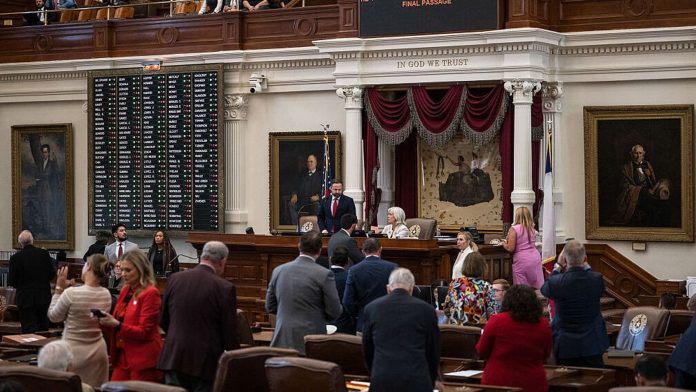Texas’ Controversial Redistricting Fight: A Battle for Power That Echoes Across America
In the steamy heart of the Lone Star State, a fierce battle over political power has ignited passions and provoked national turmoil. Recently, the lower chamber of the Texas Legislature passed a sweeping new electoral map, championed by Republican leaders as a strategic blueprint to secure the party’s grip on future congressional victories. But for many, it’s far more than lines on a map — it’s a high-stakes gambit with profound implications for American democracy itself.
Imagine the scene: legislative chambers emptied, the hum of heated debates replaced by a dramatic exodus. More than 50 Democratic lawmakers literally fled the state to prevent the vote from moving forward, a bold protest reminiscent of historic civil disobedience. Their absence stalled normal proceedings for two weeks, sending shockwaves through Texas and across the nation.
One can almost picture the tension: the dusty corridors of the Texas Capitol reverberating with the footsteps of those determined to alter the political landscape. “We had to take this stand, to shine a light on what’s really happening,” said Maria Lopez, a Democratic activist from Houston. “This isn’t just politics—it’s an assault on fair representation.”
The Map and Its Mastermind: Building a Republican Fortress
The sweeping new plan draws five additional congressional districts carefully engineered to favor Republican candidates. GOP state representative Todd Hunter, the map’s sponsor, openly acknowledged the game’s point: “The underlying goal here is straightforward—to improve Republican political performance.” No nuance, no euphemism, just unvarnished political strategy.
The vote, delayed by Democrats’ walkout, finally took place with Republicans pushing it through swiftly and along strict party lines—88 to 52. It’s now poised for final approval by the state senate and, eventually, Governor Greg Abbott’s signature. Abbott, a steadfast ally of former President Donald Trump, is expected to swiftly enact the new boundaries.
For Texas Republicans, the stakes couldn’t be higher. The 2026 midterm elections loom as a pivotal moment to defend their razor-thin majority in the U.S. House of Representatives. “This map is about more than just districts; it’s about the survival of our vision for America,” said Michael Stewart, a veteran GOP strategist based in Dallas.
Trump’s Shadow: The Former President’s Redistricting Push
No one has played a more vocal role than Donald Trump himself, whose brand of combative politics looms large over these developments. Trump heralded the map as a “Big WIN for the Great State of Texas” on his Truth Social platform, tying it to a broader cultural and political narrative about defending freedoms and the country itself.
Trump’s rhetoric was familiar, fiery, and divisive: “Texas never lets us down,” he wrote, promising “five more Congressional seats” for Republicans. He also spotlighted similar redistricting efforts brewing in battleground and GOP-leaning states such as Florida and Indiana, signaling this isn’t just a Texas story — it’s a national campaign.
Alongside calls to redraw districts, Trump renewed his longstanding crusade against mail-in voting, calling for an “END to MAIL-IN VOTING” and a switch back to paper ballots. His claim that halting mail-in ballots would translate into “100 additional seats” for Republicans paints a stark picture of how deeply electoral rules remain battlegrounds in America’s polarized democracy.
Democrats Fight Back: Legal Battles and Counterattacks
Texas Democrats see the map differently—as a brazen violation of the Voting Rights Act and an attempt to suppress minority votes and dilute Democratic power. Representative Chris Turner, from the party’s ranks, called the legislation “a clear violation of the constitution,” warning that the fight was far from over.
And he’s right. While Democrats in Texas have limited direct power to block the lawmaker-approved plan, their resistance has sparked ripples nationwide. On the West Coast, California Democrats wasted no time devising their own countermeasures. This week, they introduced three bills aimed at placing a voter referendum on November’s ballot that would implement a new congressional map designed to neutralize Texas’ impact—a rare direct referendum on redistricting issues.
Governor Gavin Newsom’s words capture the new stakes perfectly: “Nothing about this is normal anymore, and so we’re not going to act normal either. We’re fighting fire with fire, and it’s about how we play hardball now.”
Across the country, leaders in states like New York echoed that sentiment, with Governor Kathy Hochul branding the Texas plan a “legal insurrection.” What began as a localized political tussle has snowballed into a full-blown, cross-country showdown over the practical and moral boundaries of political power plays.
The Bigger Picture: Redistricting, Democracy, and the Battle for America’s Soul
Why does redistricting matter so much? Beyond the immediate electoral consequences, it touches on fundamental questions about representation, equality, and the democratic process itself. District maps can tilt the playing field, deciding whose voices get amplified and whose get muffled. When states redraw lines mid-decade—a practice legal but rarely used—it can feel like changing the rules mid-game.
For readers watching from abroad, this saga presents a vivid example of how fragile and fiercely contested democracy can be—even in one of the world’s oldest republics. It raises uncomfortable questions: Who gets to decide the boundaries of political power? How do ordinary citizens reclaim their voice when walls close in? Are systems designed to serve or to entrench those in power?
Political scientist Dr. Sara Ahmed reflected, “Redistricting fights like these reveal the ongoing tension between democratic ideals and political reality. Every line drawn is a line drawn in the sand, between inclusion and exclusion.”
What’s Next? A Nation on Edge
With the Texas map now advancing toward final approval, the reaction will be swift and widespread. Expect legal challenges in courts, renewed activism on the ground, and further political maneuvering in states from Ohio to Florida. The redistricting wars have joined the broader culture wars, blending policy, identity, and ideology into a potent political brew that will keep America’s future hanging in a delicate balance.
So, where does all this leave us, as voters and citizens? In a democracy, the right to choose one’s representatives is sacred—and never guaranteed. The evolving fight over redistricting in Texas is a gripping case study of power, protest, and the enduring struggle to ensure every vote counts.
One thing is clear: these drawn lines go far beyond the color-coded maps. They draw the contours of our political lives and our collective future. As you follow this story, consider—what kind of democracy do we want? And what are we willing to do to protect it?










